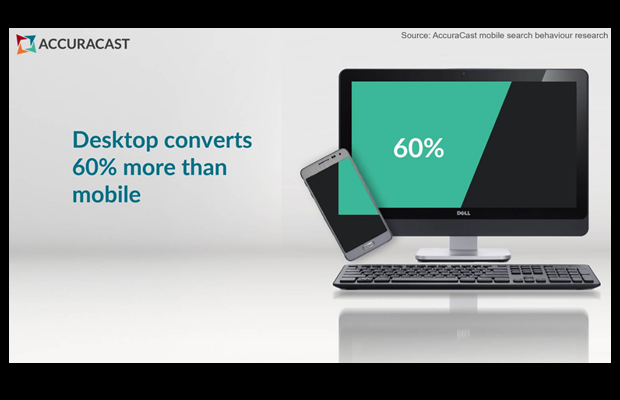Mobile ads are on the rise, with 60% of ad clicks coming from a mobile device over the past 12 months, but desktop converts almost 60% more than mobile, according to new research.
The study, unveiled this week at the Mobile Growth Summit 2019 in Berlin, also indicates that desktop conversions are worth a staggering 93% more than mobile conversions.
The research, carried out by digital makreting agency AccuraCast and presented by Farhad Divecha, UK Managing Director, analysed 10 million clicks across 100 ad accounts over the last year, comparing click and conversion trends between mobile and desktop.
In the period from August 2018-19, mobile ad clicks increased by 11 % (from 49% to 60%.) At the same time, mobile ad impressions climbed by 6%, (from 45% to 56%.). However, desktop converts 60% more than mobile, and desktop conversions are worth 93% more than mobile conversions*
*For B2C companies, conversion value was calculated as the average order value, and for B2B it was calculated as the lead value and propensity to buy.
During his presentation, Farhad summed up the research findings; “As consumer behaviour changes, we’re seeing proportionally more and more ad spend shifting from desktop to mobile devices. However, whilst consumers may be using their smartphones more to search, watch content, and connect with friends, the value for advertisers that is derived from mobile cannot be said to be keeping up.
This is a big issue for app developers who monetise their apps by allowing companies to advertise. The issue with this is that app developers are prone to focusing more on the quantity of clicks, at the expense of the user experience. Advertisers should be asking why users not feel as comfortable converting on mobile as they do on desktop? Are mobile ad clicks sending the right sort of traffic? Is my mobile ad spend driving real value for my bottom line?”
It is clear from research, that ineffective ad placements will often lead to worthless clicks, such as when apps have ads so close to an action button, or an interactive part of the app, that users end up clicking accidentally.
There is also a trust issue at play, which can affect conversions rates. The more spammy and irritating ads are on an app, the less the propensity someone will trust the companies advertising.
Farhad concluded with 4 tips for advertisers who use mobile as part of their marketing;
“Advertisers need to be wary of tracking mobile clicks alone as a primary KPI. They need to ensure mobile clicks are generating value and that they have the right attribution data in place to be able to be able to record such value.
Here are a few tips to takeaway:
• To avoid conversion drop offs, ensure your website or the landing page connected to the mobile ad is mobile user friendly and blends well with mobile transactions.
• If it’s not possible to track cross-device conversions, offer easy sharing and bookmarking options to ensure conversions later. You should then add this list of site visitors to a remarketing campaign, reminding them to convert.
• Keep track of low-quality apps – those that bring lots of traffic but no conversions – and block these apps from your campaign.
• Try different variations of ad formats and try to avoid formats that could lead to accidental clicks i.e. larger banners near a small action button.”
